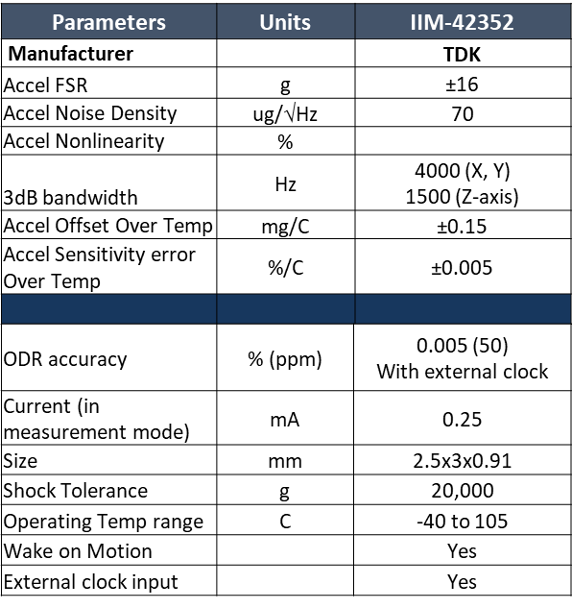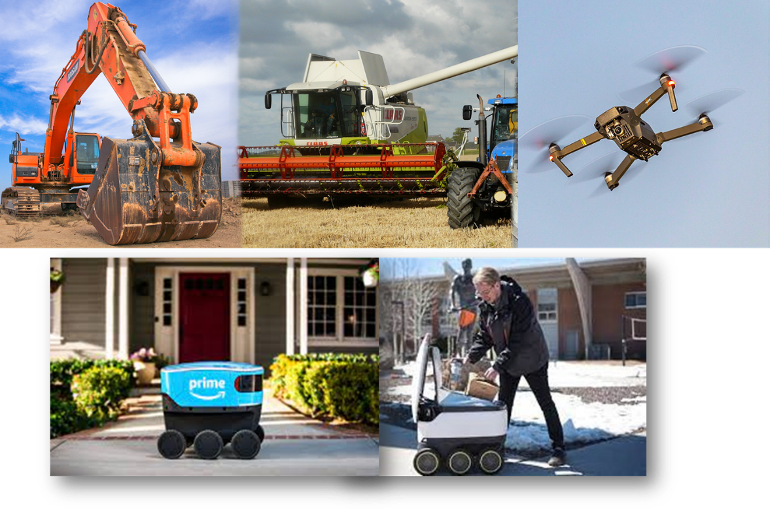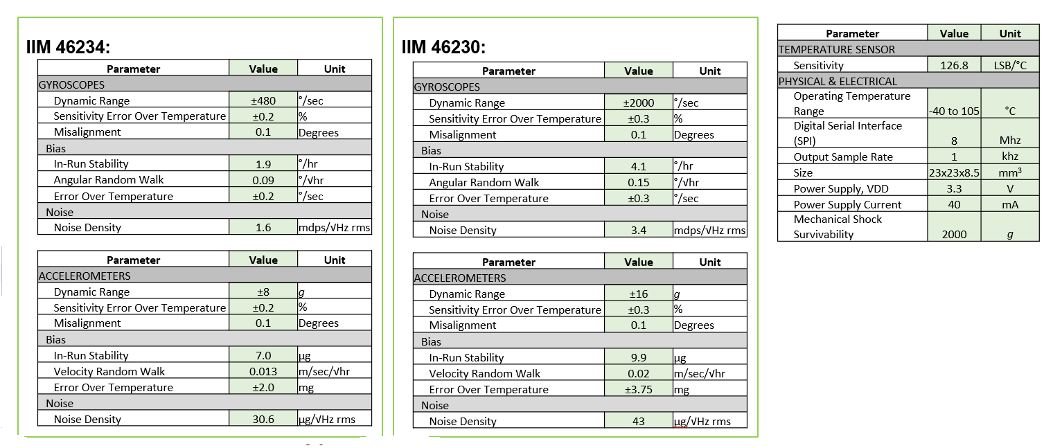Subscribe to EDOM TECH Newsletter
2022/07/07
Motion sensing, IMUs rising to the industrial challenge
Author: Camilo Delgado - Director of Product Marketing & Industrial Business at InvenSense, a TDK company
Inertial sensors systems, often referred to as inertial measurement units (IMUs), are commonly embedded into machines to monitor motion and provide information needed to interpret and react to external environment. Typically, IMUs use a multi-axis accelerometer to detect linear motion such as acceleration, shock, tilt, and vibration. Some applications also require to measure angular velocity, so IMUs commonly include a multi-axis gyroscope.
Challenge in industrial conditions
Industrial environments are among the most challenging and demanding settings in which electrical and electronic equipment operate. They are often dirty, noisy (both acoustically and electrically) and suffer from extremes of temperature, humidity, and vibration.
While the term industrial is usually synonymous with factory and manufacturing facilities, the same standards of performance are increasingly expected of surveillance equipment, agricultural, and construction and autonomous equipment, which are used outdoors and regularly subjected to harsh conditions and poor GPS visibility. Equipment operating in these environments must meet high performance standards to guarantee robustness and reliability.
Today, some of the most common applications using inertial motion sensors in harsh environments are:
- Monitoring the performance of industrial machinery
Substantial value can be gained from embedding sensors deeply in machinery to provide early and accurate detection of variations in performance. For example, inertial sensors can detect changes in vibration frequencies caused by wear and tear on bearings, allowing preventive maintenance to be performed before total equipment failure can occur.
- High precision navigation in autonomous vehicles
Autonomous machines are becoming more popular in the industrial market. Global navigation satellite system (GNSS) and inertial navigation system (INS) are commonly used to aid autonomous navigation for applications such as utility and agricultural drones, precision agriculture, and last mile delivery units. These devices are often exposed to harsh conditions such a high temperatures, high vibrations, and poor GPS visibility.
Vibration sensing
Vibration sensing is increasingly becoming popular, and it’s also required by the ISO standards. Today, most manufacturers of motors, pumps, conveyor systems and even electric vehicles are concerned about making maintenance updates at the right time. It means that servicing an equipment too soon or too late could negatively impact production.
To predict failures, condition-based monitoring systems (CBMs) are designed using MEMS vibration sensors. CBMs are higher level vibration monitors that combine multiple sensors—like temperature sensors, microphones and vibration sensors—in one system for better predictive sensing for the end application. These CBMs also have capabilities to learn the machine behavior and perform real-time analysis.
Take the example of IIM-42352, a 3-axis accelerometer designed to help CBMs manufacturers with sensing vibration needs. Capabilities of this sensor include:
Figure 1 The 3-axis accelerometer is shown along with sample vibration applications. Source: TDK
The 3-axis accelerometer is capable of measuring vibrations up to 4 kHz and can withstand shocks up to 20,000 g. Its external clock input also allows the sensor to be synchronized with the system’s microcontroller, yielding an ODR accuracy of 0.005%. This feature makes the system stable with less noise. Finally, the WOM capability provides superior power saving for customers using batteries as a power source.
Figure 2 highlights the sensor’s key features.

Figure 2 The above specification details highlight 3-axis accelerometer’s key features. (Source: TDK)
High-end industrial navigation
Then, there are 6-axis IMU modules such as IIM-46234 and IIM-46230 that include ultra-low noise MEMS based sensors to deliver precise inertial measurements, even in harsh industrial conditions. These modules combine the functionality of several gyros and accelerometers in a single package, making them ideal for applications such as high-end GNSS/INS modules used in autonomous applications. Some of the end users for these modules are smart agricultural equipment, last-mile delivery systems, and survey equipment as they require best-in-class accuracy and performance.
Figure 3 illustrates the range of applications that can benefit from the use of these modules.

Figure 3 The graphic illustration highlights applications that IMU modules can serve. Source: TDK
The capabilities of these IMU modules include:
The IMU modules also include two features that provide distinct advantages to end users.
The IIM-46234 module provides high performance in precision applications. On the other hand, the IIM-46230 module, available at a lower cost, is suitable for applications that don’t need the same level of accuracy but still require convenient, robust, and accurate inertial measurements. Figure 4 illustrates the features of each module.

Figure 4 The tables show a comparison of performance specifications for the IIM-46234 and IIM-46230 modules. Source: TDK
The IIM-46230 and IIM-46234 modules come with an evaluation kit for convenient analysis of these features.
IMUs provide machines with the ability to sense and respond to their external environment by helping them to detect acceleration, tilt, shock, vibration, and rotation. As the use of electronics increases in industrial applications, it’s imperative that IMUs withstand the demanding environmental conditions while maintaining high levels of accuracy and performance.
*Article Source: Motion sensing, IMUs rising to the industrial challenge, TDK Invensense
Inertial sensors systems, often referred to as inertial measurement units (IMUs), are commonly embedded into machines to monitor motion and provide information needed to interpret and react to external environment. Typically, IMUs use a multi-axis accelerometer to detect linear motion such as acceleration, shock, tilt, and vibration. Some applications also require to measure angular velocity, so IMUs commonly include a multi-axis gyroscope.
Challenge in industrial conditions
Industrial environments are among the most challenging and demanding settings in which electrical and electronic equipment operate. They are often dirty, noisy (both acoustically and electrically) and suffer from extremes of temperature, humidity, and vibration.
While the term industrial is usually synonymous with factory and manufacturing facilities, the same standards of performance are increasingly expected of surveillance equipment, agricultural, and construction and autonomous equipment, which are used outdoors and regularly subjected to harsh conditions and poor GPS visibility. Equipment operating in these environments must meet high performance standards to guarantee robustness and reliability.
Today, some of the most common applications using inertial motion sensors in harsh environments are:
- Monitoring the performance of industrial machinery
Substantial value can be gained from embedding sensors deeply in machinery to provide early and accurate detection of variations in performance. For example, inertial sensors can detect changes in vibration frequencies caused by wear and tear on bearings, allowing preventive maintenance to be performed before total equipment failure can occur.
- High precision navigation in autonomous vehicles
Autonomous machines are becoming more popular in the industrial market. Global navigation satellite system (GNSS) and inertial navigation system (INS) are commonly used to aid autonomous navigation for applications such as utility and agricultural drones, precision agriculture, and last mile delivery units. These devices are often exposed to harsh conditions such a high temperatures, high vibrations, and poor GPS visibility.
Vibration sensing
Vibration sensing is increasingly becoming popular, and it’s also required by the ISO standards. Today, most manufacturers of motors, pumps, conveyor systems and even electric vehicles are concerned about making maintenance updates at the right time. It means that servicing an equipment too soon or too late could negatively impact production.
To predict failures, condition-based monitoring systems (CBMs) are designed using MEMS vibration sensors. CBMs are higher level vibration monitors that combine multiple sensors—like temperature sensors, microphones and vibration sensors—in one system for better predictive sensing for the end application. These CBMs also have capabilities to learn the machine behavior and perform real-time analysis.
Take the example of IIM-42352, a 3-axis accelerometer designed to help CBMs manufacturers with sensing vibration needs. Capabilities of this sensor include:
- Configurable to 3 dB bandwidth where 2 kHz with output data rate (ODR) equals 8 kHz and 4 kHz with ODR equals 16 kHz.
- Ability to provide external clock to synchronize with the system
- Low power with typical current of 0.25 mA
- Wake on motion (WOM) interrupts based on motion detection

Figure 1 The 3-axis accelerometer is shown along with sample vibration applications. Source: TDK
The 3-axis accelerometer is capable of measuring vibrations up to 4 kHz and can withstand shocks up to 20,000 g. Its external clock input also allows the sensor to be synchronized with the system’s microcontroller, yielding an ODR accuracy of 0.005%. This feature makes the system stable with less noise. Finally, the WOM capability provides superior power saving for customers using batteries as a power source.
Figure 2 highlights the sensor’s key features.

Figure 2 The above specification details highlight 3-axis accelerometer’s key features. (Source: TDK)
High-end industrial navigation
Then, there are 6-axis IMU modules such as IIM-46234 and IIM-46230 that include ultra-low noise MEMS based sensors to deliver precise inertial measurements, even in harsh industrial conditions. These modules combine the functionality of several gyros and accelerometers in a single package, making them ideal for applications such as high-end GNSS/INS modules used in autonomous applications. Some of the end users for these modules are smart agricultural equipment, last-mile delivery systems, and survey equipment as they require best-in-class accuracy and performance.
Figure 3 illustrates the range of applications that can benefit from the use of these modules.

Figure 3 The graphic illustration highlights applications that IMU modules can serve. Source: TDK
The capabilities of these IMU modules include:
- Low bias instability with low offset and sensitivity with temperature variation
- Ability to provide triaxial, delta angle, and delta velocity outputs
- Factory calibration ensures accuracy over temperature range for bias sensitivity, misalignment, and G sensitivity.
- Dynamic correction of accelerometer and gyroscope output measurements with user-configured bias, sensitivity and misalignment values are stored.
- Reliable performance during GNSS/GPS outages
The IMU modules also include two features that provide distinct advantages to end users.
- They integrate TDK’s proprietary fault tolerance technology SensorFT, which delivers built-in redundancy and early warning system. This means that these modules can tolerate one or more internal failures without suffering complete failure. In addition, they provide continuous status changes about their level of performance, which helps extend overall end-product lifetime and scheduled maintenance.
- With precise time stamping in microseconds (25 ppm drift), the user can optionally provide an external PPS sync pulse to synchronize the internal time stamp or a UTC time stamp and PPS pulse to match internal time stamps to external system time.
The IIM-46234 module provides high performance in precision applications. On the other hand, the IIM-46230 module, available at a lower cost, is suitable for applications that don’t need the same level of accuracy but still require convenient, robust, and accurate inertial measurements. Figure 4 illustrates the features of each module.

Figure 4 The tables show a comparison of performance specifications for the IIM-46234 and IIM-46230 modules. Source: TDK
The IIM-46230 and IIM-46234 modules come with an evaluation kit for convenient analysis of these features.
IMUs provide machines with the ability to sense and respond to their external environment by helping them to detect acceleration, tilt, shock, vibration, and rotation. As the use of electronics increases in industrial applications, it’s imperative that IMUs withstand the demanding environmental conditions while maintaining high levels of accuracy and performance.
*Article Source: Motion sensing, IMUs rising to the industrial challenge, TDK Invensense






